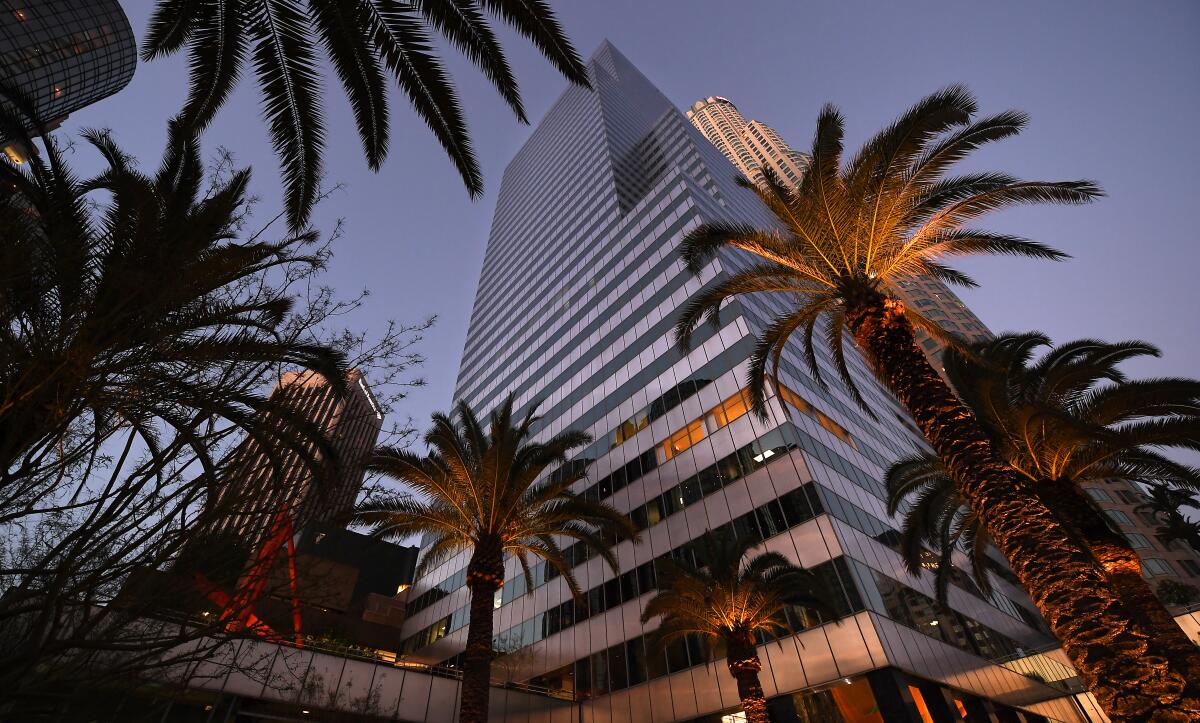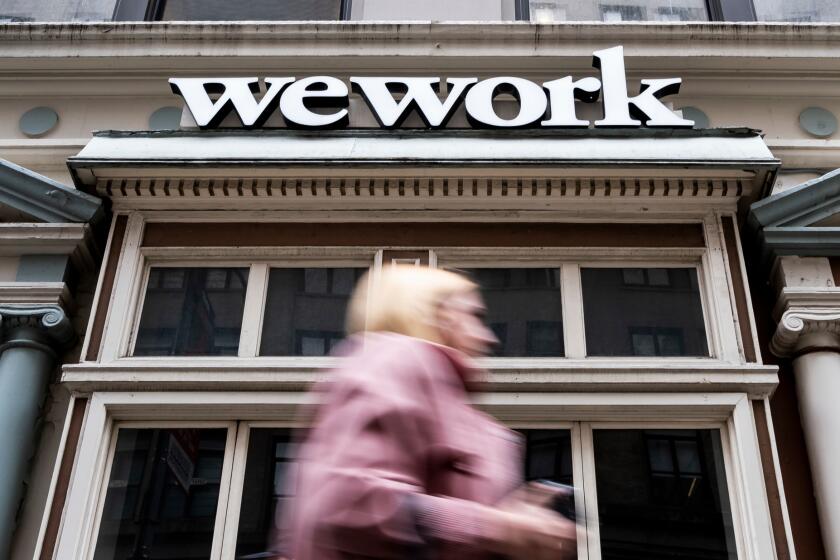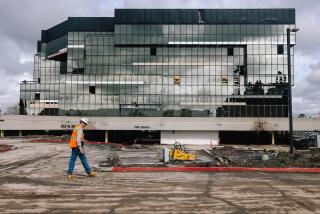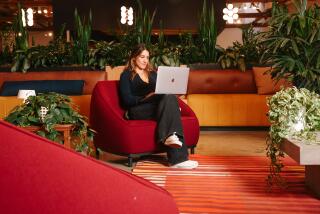Someday we’ll return to the office. It’ll be nothing like we’ve seen before

When you finally head back to the office, it won’t be like you remember it.
Physical distancing, from the garage to the elevator to the break room, promises to help make the pending mass return to the workplace both reassuring and maddening as people learn to work together again while remaining six feet apart.
Signs of separation will abound: decals on elevator floors showing you where to stand, arrows to route foot traffic in one direction, chairs removed from conference rooms and other popular gathering places.
Expect fabric couches and other upholstered furniture to be wrapped in plastic — just like at Grandma’s house — for easier disinfection. Shared work tools such as conference phones and whiteboard pens may disappear. That remote control for the lunchroom television? Don’t bother hunting for it.
Only a few states have eased shelter-in-place restrictions enough to allow widespread return to office buildings, but many landlords are planning for the comeback that they hope will be gradual. If everyone surged in as though it was a day before COVID-19, the planned systems to keep people safely apart might be overwhelmed.
Not that most workers are in a hurry to return to the offices that not long ago seemed as familiar as home, said Lenny Beaudoin of CBRE, who oversees back-to-work issues for the international real estate services company.
“We see right now that people are setting a pretty high bar around their own personal criteria for going back to work,” he said. Every aspect of office life will be scrutinized: getting there safely on public transportation, making it through the lobby, navigating once-mundane routines such as going to the restroom.
“How do I get a cup of coffee?” Beaudoin said, recalling pre-pandemic crowding around a communal pot. “Nobody is going back to work without coffee.”
People need to expect that the office will be a very different place for the foreseeable future.
“We all have habits for how we work in an office,” he said, “and those habits are going to have to change until there is a vaccine or permanent remedy.”
Adapting to new habits will be jarring, Beaudoin predicted, but workers will shift as they did after Sept. 11 when heightened security procedures that slowed entry went from annoying to normal. Dealing with inconveniences and delays brought on by coronavirus safety measures will also become a habit, he said.
Getting to that point, however, will be a formidable challenge for landlords like the owners of a downtown L.A. skyscraper that has stood in many times for fictional corporate headquarters in films and TV shows, including the 1980s legal drama “L.A. Law.”
Before the pandemic, the 48-story tower at 444 S. Flower St. had the population of a small town, about 7,000 people. Only a handful show up nowadays and can easily stay far apart, but owner Coretrust Capital Partners is preparing for more to arrive as early as mid May.
Their goal is to reduce the likelihood that occupants will contract the virus while signaling to nervous tenants that it’s OK to come back inside.
“It’s all about, how do you get your tenants to feel safe?” said John Sischo, a managing principal at Coretrust.
The shoulder-to-shoulder business model of sharing office space might have difficulty recovering from the coronavirus outbreak.
Small measures may start with return-to-work gift bags containing hand sanitizer, gloves and masks to be handed out as tenants arrive. Lanes for foot traffic will be marked and doors to the lobby will be kept open so no one needs to worry about germy handles. Security guards will make sure people come and go from the garage in a single direction.
Elevators can be dispatched to assigned floors electronically, so no one has to touch a button. Only a few at a time will be allowed to use them.
Like other landlords, Coretrust is ambivalent about screening arrivals for fever by use of thermometers or more sophisticated thermal imaging devices. What if they barred someone on the way to an important meeting on a false-positive reading?
“We are very concerned about the ramifications of thermal checking,” said Tom Ricci, another managing principal of Coretrust. “It’s probably best left to tenants, but it’s something we are exploring.”
Among less visible measures, the landlord will try to boost indoor air quality with high-efficiency filters and perhaps ultraviolet light disinfection of mechanical systems that pump air through the building.
In most commercial buildings, the landlord is also responsible for cleaning the offices rented by tenants. The significance of that nearly invisible service has jumped, Ricci said, because tenants want to know steps are being taken to thwart the spread of the novel coronavirus.
“For at least the next year, janitorial is going to play a large role in all of our properties,” he said.
Before the pandemic, janitorial services were viewed by many companies as overhead costs that should be kept to a minimum, said Laurie Sewell, president of Servicon Systems Inc., a Culver City cleaning service provider.
“People didn’t want to spend a lot of money on cleaning because if it looked clean it was OK,” she said. “But it’s not what you can see; it’s what you can’t see.”
Servicon, which specializes in sanitizing so-called critical environments such as industrial clean rooms, operating rooms and other medical facilities, hired 120 people in April in expectation of working for office owners and other businesses planning to elevate their cleaning procedures.
Only a few months ago, it was fairly standard for office cleaning to consist of dumping trash and vacuuming, the indoor equivalent of a home gardener’s “mow and blow” yard cleanup, Sewell said. Some landlords saved money by turning off the hot water in the restrooms, which often were, however, the one part of the office that actually got disinfected by janitors.
Sewell predicts that many offices will now be regularly disinfected electrostatically using a charged solution that clings to surfaces and kills germs in hard-to-reach places. Such thoroughness can drive up the cost of cleaning as much as 50%, she said.
Keeping surfaces clean may require new edicts from managers about limiting personal objects on desks or at least requiring them to be stowed away at night. Objects with porous surfaces, such as plush toys, are hard to keep clean.
“No more Beanie Babies,” Sewell said.
She predicted that many managers will follow a strict clean-desk policy recommended by real estate services company Cushman & Wakefield, which calls for disposable paper place mats for each desk that would be changed daily as employees sanitize their personal space.
And about that coffee?
You may need to bring your own because Cushman’s suggested rules say that coffee pots should be removed and that open food items such as a box of doughnuts should be verboten. Only prepackaged items in containers would be allowed.
If this is starting to sound like work is going to be less fun, you are right.
People-oriented perks and pleasures that were added to office complexes in recent years are going to be gone for the time being, said Marty Caverly, who oversees property management for Los Angeles real estate company Lowe.
“The last real estate cycle was an amenities war,” Caverly said, with office landlords trying to attract tenants by offering extras such as gyms, training rooms and game lounges. “Out of the gate, we are going to have to shut those things down.”
Instead, safety will be the enticing amenity, in part because people need human connection and desire to be among their work colleagues, he said.
“Now we have the burden of making them feel safe doing it,” Caverly said. “If you do that correctly, they will stay in your building longer.”
Recent surveys of Lowe’s tenants show “all of them want to come back,” he said, perhaps starting in phases as designated teams work Monday, Wednesday and Friday, while others work Tuesday and Thursday.
That’s part of the recently announced return plan for design firm Bergmeyer, which has an office in downtown Los Angeles. Company leaders are taking a gentle approach with employees and told them that they may continue to work at home for the foreseeable future, but that executives “recognize that there are many people eager to return to the office as soon as it’s safe to do so.”
Distancing measures will be in place and everyone is “encouraged” to wear a face mask through mid-July. Coffee makers and tea stations will be unavailable and no more than three people at a time can visit the restroom. Daily cleaning will be a constant health measure.
Some of the changes in office use such as reduced desk density will probably continue after the threat of the virus has passed, CBRE’s Beaudoin said, and companies may permanently adjust staffing patterns as working from home gets further ingrained in their culture.
“But are we going to radically change the way people work? No,” he said. “This too shall pass.”
More to Read
Inside the business of entertainment
The Wide Shot brings you news, analysis and insights on everything from streaming wars to production — and what it all means for the future.
You may occasionally receive promotional content from the Los Angeles Times.












